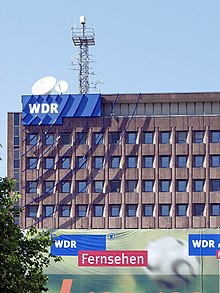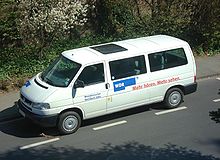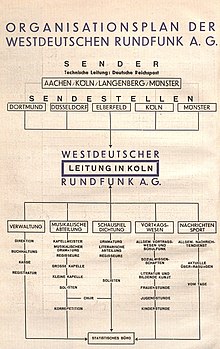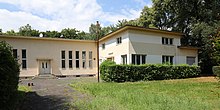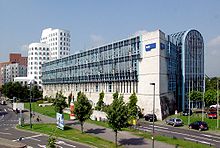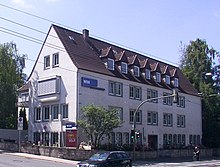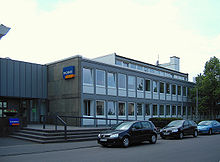West German Broadcasting Cologne
| West German Broadcasting Cologne | |
|---|---|
| Station logo | |
|
|
|
| General information | |
| Seat: | Cologne |
| Intendant: | Tom Buhrow |
| Radio: |
1 Live 1 Live diggi COSMO (together with Radio Bremen and RBB ) WDR 2 WDR 3 WDR 4 WDR 5 WDR Event WDR VERA 1 Live Art (formerly) KiRaKa (formerly) WDR 1 (formerly) WDR 2 Klassik (formerly) |
| Watch TV: | WDR television |
| Sound body: |
WDR Big Band WDR Rundfunkchor Köln WDR Funkhausorchester WDR Sinfonieorchester |
| Legal form: | Institute of public right |
| Website: | www.wdr.de |
The West German Radio in Cologne ( WDR ) is a public institution ( state broadcaster ) of the country North Rhine-Westphalia , based in Cologne , the Radio and Television operates and related activities. In addition, WDR is a member of ARD and its largest broadcaster and - in terms of the number of employees - the second largest broadcaster in Europe after the BBC . It was created in 1956 when the NWDR was split into the NDR and the WDR . The legal basis of the WDR is the law on West German Broadcasting in Cologne ( WDR law ), which the state of North Rhine-Westphalia announced on April 25, 1998.
Programs
The WDR currently broadcasts the following television and radio programs, either alone or in cooperation with other radio or television companies:
The first
The WDR delivers formats such as Monitor , Die Sendung mit der Maus , ARD morning magazine , Sportschau and soaps such as Lindenstrasse and Verbotene Liebe to the First German Television . Big TV games like the Durbridge classics Das Halstuch , Tim Frazer , Melissa , which were real street sweepers , like Die Manns , Speer and Er or Anniversaries after Uwe Johnson come from the NRW broadcaster. The WDR is within the ARD with a 21.25% share of the total program, ahead of SWR and NDR , the largest broadcast supplier. Jörg Schönenborn has been TV director of WDR since May 2014 .
WDR television
WDR television is the so-called third television program on German television for North Rhine-Westphalia. The term “third program” comes from the time when there were only Das Erste and ZDF as full programs in Germany and the only regionally broadcast television programs were the third programs in their area of distribution. The analog television broadcasting was gradually replaced in the years 2004 to 2007, DVB-T.
Radio
- 1 live youth program for the target group 14–39
- WDR 2 - officially called Informationsleitwelle, target group 25–59, strong regionalization
- WDR 3 - Kulturfunk, high proportion of classical music, next to jazz niches, interspersed word programs, no advertising
- WDR 4 - wave of entertainment, hits, oldies and hits from West German broadcasting, no advertising
- WDR 5 - wave of education and information with a high proportion of words, only short interludes (often jazz), two children's programs a day, no advertising
- COSMO - “Global Sounds Radio”, in German during the day (in cooperation with Radio Bremen ), in 14 other languages in the evening, no advertising
Only DAB ( Digital Radio ) as well as DVB-S and partly DVB-C are broadcast:
- 1 Live diggi - music and news from 1 Live
- KIRAKA - children's program broadcast since 2006 (KInderRAdioKAnal)
- WDR Info - data and news service of the WDR with visual information
- WDR Event - event program for special occasions
- WDR VERA - Traffic news from a computer spoken non-stop in full length
Former radio programs are:
- WDR 1 - predecessor of 1 Live
- WDR 2 Classic - contributions from WDR 2 classical music, briefly by the online service after setting My WDR radio replaced
- 1 Live art - web radio with cultural topics and sophisticated pop music
- Radio Dortmund
Web and teletext
The WDR programs are accompanied by offers on the Internet and via teletext . A web editorial team consisting of more than 30 people is responsible for these areas, which is primarily responsible for preparing the contributions from the radio and television programs, but sometimes also provides its own content.
magazine
The WDR publishes its own magazine called WDR print . The brochure appears monthly and provides 42 pages with information about new WDR productions on the radio, on television and on the Internet. The printed edition of WDR print can be subscribed to free of charge.
financing
The main source of funding since 2013 has been the license fee (until 2012: license fee ). In 2010, WDR's revenue from broadcasting fees was € 1.128 billion, which corresponds to 79.8 percent of total revenues of € 1.419 billion. In addition, through its advertising subsidiary WDR mediagroup, WDR generates income from the sale of advertising in the radio programs 1 Live, WDR 2 and WDR 4 as well as the regional advertising blocks for NRW in the evening program of Das Erste , as well as from sponsorship . In 2011, he generated income totaling € 36 million (2.6%) from these sources. In 2011, an annual average of 4,132.5 positions were filled at WDR.
Contribution income of the WDR including a share of 1.8989% for the financing of the state media authorities :
| year | Premium income | source |
|---|---|---|
| 2013 | € 1,152,637,100 | |
| 2014 | € 1,245,870,000 | |
| 2015 | € 1,204,623,900 | |
| 2016 | € 1,179,417,100 | |
| 2017 | € 1,176,566,500 | |
| 2018 | € 1,169,596,000 |
criticism
In the 1970s, representatives of the CDU and related press organs often referred to the WDR as politically left-wing, which crystallized in the claim " Rotfunk " , which continued into the 1990s . Many WDR employees were assumed to be very close to the SPD , and some also sympathized with the Baader Meinhof Group (RAF).
There is also criticism of the strong focus of reporting and the station's production locations on the metropolitan areas in the Rhineland (especially in the Cologne area ) and in the Ruhr area and the associated disadvantage of the more rural Westphalian part of North Rhine - Westphalia . This criticism hits all non-regional broadcasters of the ARD.
Ruth Hieronymi , chairwoman of the WDR program committee, criticized the very high hurdle for program complaints in 2010 and announced that she would advocate clarification. The reason for this criticism was the only successful program complaint submitted by media scientist Wolfgang Stock in the committee's tenth term. The complaint against the "Unwanted cure" feature by Klaus Martens in October 2009 was about oversimplification and one-sided reporting and thus violation of journalistic fairness in the documentation about a neurodermatitis ointment shortly before its market launch.
The WDR 3 program has been through several structural reforms since 2004, some of which have met with massive criticism from outside. See WDR 3 program reforms .
There is criticism of the amount of the salary and the additional income of the artistic director Tom Buhrow and his predecessors and also the colleagues of the other public broadcasters in Germany. Buhrow's annual salary, including benefits in kind, was 407,100 euros in 2017.
At the beginning of 2014 critical reports appeared that the WDR had acquired a non-public art collection of over 600 works as an investment with income from broadcasting fees .
In 2018, there were allegations that WDR executives had not taken indications of sexual harassment by several employees seriously enough in recent years. Former EU Commissioner Monika Wulf-Mathies was brought in as an external expert to check how managers were dealing with these allegations. Gebhard Henke, head of the television film, cinema and series program area, was released after six women, including Charlotte Roche , accused him of sexual harassment.
In 2020, artistic director Tom Buhrow apologized for a satirical children's song broadcast on WDR 2 and had the video deleted. In the video, a children's choir sang, among other things, "My grandma is an old environmental pig". The deletion of the song was understood by many employees as "buckling". The song called opponents of public broadcasting and right-wing forces on the scene, who demonstrated in Cologne, Baden-Baden and other locations.
history
The beginnings
Westdeutsche Funkstunde AG (WEFAG) from 1924
Between October 1923 and September 1924, the German Reich was almost completely covered by a network of radio stations. In the areas of the Rhine and Ruhr that were occupied by Allied troops after the First World War , the construction of German-language transmitters was prohibited. That is why the first transmitter for the Ruhr area was set up in the unoccupied Münster a little late. For this purpose, the first attempts with a Lorenz transmitter began on July 17, 1924, and the “ Westdeutsche Funkstunde AG ” (WEFAG) was founded on September 15, which officially began operating on October 10 and broadcasts radio programs under the code “Münster I “Radiated. The wavelength of 410 m enabled an unexpectedly long range. The radio lesson was conducted by Hermann Krome , initially with a four-man orchestra and a few records. When it started broadcasting, WEFAG had 6114 registered listeners, and a month later it had 9099.
In May 1925, the Reichs-Rundfunk-Gesellschaft (RRG) was founded in Berlin as the umbrella organization of the regional broadcasting companies in the German Reich , which initially comprised the companies NORAG (Hamburg), MIRAG (Leipzig), SÜWRAG (Frankfurt / M.) ORAG (Königsberg i . Pr.) And Schlesische Funkstunde (Breslau) joined. After sometimes lengthy negotiations, WEFAG, Funk-Hour Berlin and Stuttgart-based SÜRAG also joined, while Bayerische Rundfunk (until 1930 Deutscheunde in Bavaria ) only became a partner in RRG in 1931 due to financial bottlenecks .
When the occupation of the Ruhr area ended in the summer of 1925 , thousands of "black listeners" living there acquired broadcasting licenses; the number of official radio listeners rose in 1925 from 13,950 to 83,400, about six times as much. On July 21, 1925, the first sports broadcast on German radio presumably took place on the Dortmund-Ems Canal near Münster, where the reporter was not on the transmitter, but on the microphone. The Rundfunk Jahrbuch 1933 describes it as the: "... first attempts to get the microphone out of the narrow broadcasting room and put it in the middle of life, [...] in order to run a rowing race to the amazement of the people according to a carefully prepared plan Handset. Today we can hardly imagine the enthusiasm of that time about the extraordinary novelty, and only very few of the listeners of that time will be aware at the moment that this has become the starting point for the time broadcast that is so important today. "
Westdeutsche Rundfunk AG (WERAG) from 1927
The success forced WEFAG to expand to the west and to open two secondary transmitters on September 18 and 19, 1925 in Dortmund ( Dortmund-Dorstfeld transmitter ) and Elberfeld, today a district of Wuppertal ( Elberfeld transmitter location ). On October 29, 1926, the WEFAG supervisory board decided to relocate the headquarters from Münster to Cologne and at the same time rename it to “Westdeutsche Rundfunk AG” (WERAG) on January 1, 1927. She moved into a building at Dagobertstrasse 38 in Cologne . WERAG went on air for the first time on January 15, 1927 at 8 p.m. with the commissioning of the new Langenberg transmitter on the Hordtberg near Langenberg (now a district of Velbert ). (The Langenberg site now serves as a basic television network transmitter and for broadcasting VHF radio analogue and DAB .)
However, the Langenberg transmitter turned out to be too weak to supply Cologne. For this reason, construction work on a transmitter in Cologne-Raderthal began as early as May 1927 . At the time, 94 locations had applied for this station. However, the then mayor of Cologne, Konrad Adenauer , managed to bring the system to Cologne. On September 1, 1927, the transmitter successfully commenced trial operation on Wave 283 with 4 kW transmission power in Cologne's Hitzelerstraße. The official commissioning took place on December 15, 1927.
From the end of 1926, WERAG published a program magazine under the title of the same name. It was published weekly by the in-house Rufu publishing house. Later, based on the model of the BBC Yearbooks , the same publisher published the yearbooks of West German Broadcasting with the station's internal information, but above all with the intendant's "high-spirited" broadcast manuscripts printed over long distances. In the first edition of Werag - the official organ of Westdeutsche Rundfunk AG Cologne , in December 1926, the Reich Minister of the Post and his Reich Broadcasting Commissioner congratulated the official start of West German Broadcasting with solid transmission power and a new broadcasting house. While Post Minister Karl Stingl saw the "Rundfunk im Rheinland [...] called" to "consolidate the Germans on the Rhine and Ruhr in their nationality", Broadcasting Commissioner Hans Bredow drew attention to the technical achievement:
“It was not without compelling reasons that the Rhineland-Westphalia transmitter received the extraordinary energy of 25 KW tube power. If you wanted to create a transmitter for the large industrial district on the Rhine and Ruhr, which, despite the extremely difficult reception conditions in the midst of the masses of metal in the mines and smelting works, the factory chimneys, the electric power plants, you hardly had to go to this transmitter so far the performance that has occurred. But this guarantees that the voice of the Hardtberg will penetrate everywhere and, more than that, carry the waves of German intellectual life far beyond the borders of Germany. "
In 1926, on the recommendation of the Mayor of Cologne Konrad Adenauer, the writer Ernst Hardt was appointed director . He was soon targeted by the right-wing press; so quoted the radio magazine Der Deutsche Sender in January 1932 the West German observer ("The Cologne National Socialist Daily"):
“Under the direction of Ernst Hardt, Westdeutscher Rundfunk has developed into a hotbed of pro-Bolshevik disintegration work. Just imagine: Of the nine departments of West German Broadcasting, the seven most important ones are occupied by Jews! "
The West German observer wrote about Hardt's salary:
“Intendant Hardt 4,000 marks a month, a bonus of 12,000 marks a year; a special monetary compensation for every microphone service (e.g. for the performance of a poem - duration ten minutes!) - around 150 tax marks! "
National Socialism
Immediately after the seizure of power in 1933, Propaganda Minister Joseph Goebbels rebuilt the German broadcasting landscape within a few weeks. First he fired all directors (except for Alfred Bofinger in Stuttgart). In April 1933, the NSDAP functionary, SS man and archivist Heinrich Glasmeier succeeded the released and arrested Ernst Hardt . Goebbels was personally present at the inauguration on April 24, 1933. The Reichs-Rundfunk-Gesellschaft RRG praised Glasmeier's appointment as artistic director, because as an archivist he had shown his “National Socialist basic view of blood and soil ”. Around 13% of the workforce was also given notice from April 1933. The alignment was quick, because the program advisory board was dissolved in September 1933, and WERAG was dissolved on March 20, 1934 after the Prussian state had to cede its shares. The nationalization of WERAG led to its renaming to "Reichssender Köln", which later became part of the Greater German Broadcasting Corporation .
The Propaganda Ministry took up efforts that had already been considered in the Weimar period to merge the programs of the local broadcasters. It began with the merger of the Cologne station with the Frankfurt and Stuttgart stations to form a "Sendergruppe West" in the summer of 1933. This was announced with a broadcast that showed the listeners in the common broadcasting area the change from one program to the other live. What was sold to the outside as a technical masterpiece primarily served to save 4 million Reichsmarks by merging the programs. From then on, the three stations shared the departments on the instructions of the Reichsrundfunkgesellschaft. Cologne was responsible for the great symphonic music and physical training (gymnastics programs, etc.). The protests, especially from the churches, were substantial. Stuttgart was only allowed to send Protestant and Cologne only Catholic masses. Numerous programs fell victim to centralization, with the corresponding losses for the artists and authors of the individual channels. Even Reich Propaganda Minister Goebbels came to this centralization too quickly, and at the end of 1933 he began to disband the broadcasting groups again. In order to soothe the anger of radio writers loyal to the line who had become unemployed, he instructed a special distribution of 100,000 Reichsmarks "so that hundreds of free artists can be given Christmas joy".
The radio show The Merry Saturday Afternoon , which was broadcast almost continuously with almost 150 episodes from November 24, 1934 to December 31, 1939, developed into one of the most popular radio series of that time with its musical performances by German dance orchestras and sketches . That is why it was broadcast nationwide from May 1935. On October 10, 1935, a tornado destroyed the transmission tower of the Langenberg transmitter , and on March 1, 1936, the "Reichssender Köln" began its cooperation with the State University of Music in Cologne. NS-Intendant Glasmeier was appointed "Reichsintendent des Deutschen Rundfunks" on March 19, 1937 and was thus the superior of the directors of all Reich broadcasters. On June 9, 1940, the Reich program was introduced as a "community program" for all Reich broadcasters, who only had the morning program to manage.
After the former "Reichssender Köln" was bombed during the Second World War on the night of June 28-29, 1943, work began in April 1948 on building a new broadcasting house in downtown Cologne not far from the cathedral under the name Funkhaus Wallrafplatz . The Monopol Hotel , which had been largely destroyed in the war and whose ruins were integrated into the new building , had previously been in the same location , with both cost pressure and material shortages playing a role. The 25 percent of the structure of the destroyed hotel that could still be used was included.
Federal Republic
In post-war Germany, the British occupying power first founded “Radio Hamburg” in their area on May 4, 1945, which from September 22, 1945 became the “ Nordwestdeutscher Rundfunk ” (NWDR) joint broadcasting company for the entire British zone including Berlin. The main transmitter location was Hamburg. In Cologne there was another radio station (Dagobertstrasse 38), which was badly damaged by the war and which was able to provisionally start broadcasting on September 26, 1945. From here the institute broadcast its one-hour program on its own. From January 1, 1946, the single-wave operation began with the NWDR Hamburg, and from mid-August 1946 the NWDR Berlin was integrated. The NWDR was handed over by the military government on December 30, 1947 and, through the Broadcasting Act, became an institution under public law for the states of Hamburg, Lower Saxony, Schleswig-Holstein, North Rhine-Westphalia and Berlin. The leadership of the NWDR remained British, however, because the first director general was from January 1, 1948 Hugh Carleton Greene , the chief controller of the BBC.
The NWDR


The NWDR initially only broadcast one program (later NWDR 1 ). From 1950, two regional radio programs followed VHF , NWDR Nord (later NDR 2 ) and NWDR West (later WDR 2 ). In the same year the NWDR was a founding member of the ARD . Two years later (1952) the NWDR was largely responsible for the restart of television in Germany. On June 21, 1952, the Wallrafplatz radio house was opened, from which the first television program was broadcast on December 25, 1952 - for an estimated 200 television viewers in the Cologne region. On June 1, 1954, the newly founded broadcaster Free Berlin (SFB) left the NWDR in order to broadcast independent programs for the state of Berlin. In the same year, the joint TV program of the ARD started.
In February 1955, the regulated states of Hamburg , Lower Saxony , Schleswig-Holstein and North Rhine-Westphalia to broadcasting in their countries new. As a result, the NWDR was split into two independent broadcasters. The " NDR ", based in Hamburg, was to organize radio broadcasts for the states of Hamburg, Lower Saxony and Schleswig-Holstein and the "Westdeutsche Rundfunk Köln", based in Cologne, for the state of North Rhine-Westphalia. On January 1, 1956, the two new broadcasters started their own radio broadcasts. From April 1, 1956, the " North and West German Broadcasting Association " (NWRV) took over the television sector until 1961. Then both broadcasters were also responsible for their respective broadcasting areas in the television sector.
Three radio programs
From 1956 onwards, WDR initially broadcast two radio programs, WDR 1 and WDR 2 , and contributed its share to the ARD community program of German television. The first radio program (WDR 1) was partly operated jointly with the NDR until 1986, after which it was gradually expanded into a wave for 14 to 39 year olds.
During the Christmas holidays 1954/55 and one and two years later (until 1956/57), WDR and NDR first broadcast WDR 3 and NDR 3 based on the BBC's third program ; the programs, like those of the BBC, were aimed at an “upscale” audience. After test runs for a full program in 1962, the WDR broadcast “ WDR 3 ” five days a week from January 1, 1963 : cultural programs , classical music and, for the first time, radio plays. From March 30, 1964, the 3rd radio program was on the air every day.
Color television test laboratory
From 1963 to the end of 1969 the introduction of PAL color television in Germany was prepared in the WDR “color television test laboratory” in Cologne-Ehrenfeld with its own studio equipment developments and the daily broadcast of special color test images and films . Franz Josef In der Smitten was in charge of it , and from 1974 he took over the chair for communications technology with a focus on television and radio technology at the Bergische Universität Wuppertal . One of the first colored outside broadcasts in the PAL test operation came from the Cologne Rose Monday procession. In the Smitten it was possible with his employees to record the aforementioned Rose Monday procession in PAL with a self-modified TR22 magnetic tape machine and to play it back successfully; this was a particularly remarkable achievement, as there were strong doubts among experts at the time whether this would ever be possible. The essential equipment of the laboratory is now, maintained by a group of people who were formerly involved in the experimental operation, still functional at the Bergische Universität Wuppertal and is open to interested parties as part of guided tours.
In the ARD sports show from Cologne, the “football ballet” caused a sensation - a special function developed by a WDR technician for the new “electronic slow motion”, a special hard disk the size of a cart wheel ( Ampex HS-100), on which the analog working read and write head was moved back and forth in a targeted manner, so that the video recording could be played back and forth slowly or quickly.
Start of the 3rd television program
On December 17, 1965 (official start of regular operations in 1967), the WDR started broadcasting its own “ Third Television Program ”, initially as “West German Television” (WDF, from 1988 West 3), which was expanded to a full program from 1991 and in the meantime can also be received via satellite in almost all of Europe. Since 1994 it has been run as WDR television .
Between 1965 and 1970, a new frequency at the upper end of the range was set for the medium wave transmitter in Langenberg (1586 kHz until 1978, 1593 kHz from 1978) and its output was increased to 800 kilowatts, which made this station one of the most distinctive transmitters in the medium wave range. In 1980 a second medium-wave transmitter went into operation in Langenberg, which was only operated during the day until 1995 due to the requirements of the Geneva Wave Plan .
First teletext
On January 3, 1983, the WDR started its regional teletext service WDR-Text on the TV program “West 3” . It was the first regional teletext offer from an ARD broadcaster. The "System Development and Training" department (which has since been completed) had significantly collaborated with the IRT Munich on the technical implementation of the German teletext format.
Since January 1983 the " WDR Computerclub ", designed by Wolfgang Back and Wolfgang Rudolph , has also been broadcast on "West 3". The computer club was one of the first German television programs to deal with the subjects of computers and technology in general. It was soon broadcast on numerous third-party programs on German television.
Start of WDR 4 and 5
On January 1, 1984 the WDR started its 4th radio program ( WDR 4 ) with mainly German light music, which has been a full program since January 1, 1985. At the same time, 5 regional programs from Bielefeld, Düsseldorf, Essen, Cologne and Münster started on the radio. In the course of regionalization, window programs were set up from 1984 onwards, which intensified television reporting “on site”. The prerequisite for this was the introduction of the “electronic reporting” that had recently been developed using professional magnetic recording machines with 3/4 inch magnetic tape cassettes of the U-matic type . The first "report trolleys" were used with this technology for quick field operations. H. small 3.5 ton trucks used as mobile mini studios. At the beginning of the 1990s, the Betacam SP 1/2-inch format, which was better in terms of image and sound, replaced the bulky large cassettes with shoulder-friendly camcorders. The recording technology previously used in the studio with cabinet-sized MAZ machines and 2-inch magnetic tapes the size of cartwheels had become obsolete.
On January 15, 1985, the transmitter mast on the Bielstein collapsed due to icing. Radio advertising has been broadcast in radio programs since 1987; initially only on WDR 2 and WDR 4 , from 1995 also in the first program.
On May 29, 1989, the WDR broadcast as the first broadcasting company in continental Europe from the Cologne Philharmonic with the help of a fully digitized recording, mixing and production studio (CD identification: DDD). On October 7, 1991, the WDR started the North Rhine-Westphalia wave WDR Radio 5 on the broadcasting chain of WDR 1, which switched to a new fifth FM broadcasting chain.
After the failure of the European HDTV standard HD-MAC (1250 lines) and the D2MAC derived therefrom (625 lines, both in 16: 9 format with digital multi-channel sound), an attempt was made from 1993 onwards with the help of WDR system development to enable the new analog broadcasting process PALplus to use the 16: 9 picture format in the existing terrestrial broadcasting and cable TV network. The new TV receivers required for this were too expensive for most viewers.
At the end of 1993, the long-range medium wave transmitter for the frequency 1593 kHz, which was known to every DXer , was shut down because of PCBs in the capacitors and other components.
1Live and Funkhaus Europa
On April 1, 1995, the WDR 1 program was completely redesigned as a rock and pop wave and is now called 1 Live (until January 4, 2007: Eins Live ).
On September 2, 1996, a 160 meter high transmission mast collapsed in Langenberg during maintenance work.
On February 11, 1998, GMD and the Westdeutscher Rundfunk Köln accidentally triggered a worldwide email avalanche .
On May 1, 1999, WDR launched its international and intercultural radio wave “ Funkhaus Europa ”, which is aimed at a broad audience in German during the day and broadcasts in the most important mother tongues of immigrants in Germany in the evening. The program is created in cooperation with Radio Bremen ; In addition, the RBB also delivers individual consignments.
In 2000, the artistic director Fritz Pleitgen launched an internet offensive for the WDR. The aim of this was to develop the Internet into a further mainstay of the WDR in addition to the conventional radio and television programs. In this context, in April 2000, a dedicated internet editorial team was founded with 31 full-time employees today. However, the Internet offensive is also cause for criticism, as the WDR wanted to get hold of numerous domains in this context even before the start of the Internet editorial office and also proceeded with inappropriate methods. On the one hand, the case of Wolf-Dieter Roth , a journalist for whom the WDR contested the domain wdr.org, and, on the other hand, the repossession of the domain wdr.com used by WDR in the early days and then released in favor of wdr.de, became known , which in the meantime was the website of the investment bank Warburg Dillon Read . However, both domains did not remain in the possession of the sender after the processes were completed.
At the beginning of 2004, WDR invested in the first HDTV production equipment ( HDCAM , Nitris editing computer) in the MPEG2 standard, and more and more television productions were made in multi-channel audio technology ( Dolby Digital ) and in 16: 9 image format. These could now be broadcast digitally in high quality via DVB-S (satellite), DVB-C (cable) and DVB-T (terrestrial).
At the 2005 World Youth Day in Cologne, WDR produced the international image for TV stations around the world. Artistic director Pleitgen said that the largest WDR production in 15 years had "Olympic dimensions". 700 people were employed for the Pope's visit alone and well over 120 cameras were in use.
On April 19, 2012 it was announced that the WDR will gradually receive a new logo on all levels by 2014. The reason for the re-branding is that the old, previous logo is difficult to read in the digital world.
building
WDR is spread over nine of its own buildings in downtown Cologne. The increasing importance of the station and the increase in programs made it necessary to expand the space. Most of the buildings were built next to each other over a length of almost 700 meters in an east-west direction. The building chronology begins with the Wallrafplatz radio station (address: Wallrafplatz 5), which was inaugurated on June 21, 1952. It houses a large part of the WDR radio with production studios for word and music broadcasts, parts of the sound archive, the radio technology and the broadcasting center. Events are often recorded from the small and large broadcasting hall. This was followed in March 1965 by the “Haus Rechtschule” ( An der Rechtschule 2) with television studios and the “Haus Berlich” ( Breite Straße 92–98; 1965–1967) with the WDR facility management. In 1966, the building (built in 1903/1904) directly to the north of the Funkhaus Wallrafplatz was acquired by the WDR and rebuilt almost true to the original in the Gothic style. It houses the broadcasting center for WDR radio and the “Café Reichard” on the ground floor. Then in 1968 the "WDR Archivhaus" (An der Rechtschule 4) built on the north-south route and the Vierscheibenhaus opened on June 27, 1970 with the official postal address of the WDR ( Appellhofplatz 1, 50667 Cologne). Also on Appellhofplatz is the " WDR-Filmhaus " (for the production associated with film; 1974) as a joint between the four-pane house and the archive building. The "Haus Forum" is a red brick building from the Wilhelminian era that was acquired by the WDR in 1965 (Kupfergasse 8). The " WDR Arkaden " (Elstergasse) house, among other things, the central newsroom for all news programs of the WDR radio programs, the news anchors are integrated into the newsroom ; the central WDR canteen is also located in the building. After the foundation stone was laid on October 11, 1994, it was inaugurated in October 1996. Since 1996 the directorate has been located here. The “ 1Live-Haus ” (Neven-Du-Mont-Straße 4–6) is mainly used for broadcasting for 1Live . This radio program has been broadcasting from MediaPark since April 1997 until it moved into its own studios in March 2012. The WDR mediagroup has been located at Ludwigstrasse 11 since 1980.
organization
The station's director was Monika Piel until April 30, 2013 , who left the company prematurely for personal reasons. On May 29, 2013 Tom Buhrow was elected by 41 of the 47 present members of the Broadcasting Council as the new director of the WDR. Five directors report to the directorship, who are responsible for the following areas:
- Jörg Schönenborn : Television
- Valerie Weber : Radio
- Wolfgang Wagner : Production and Technology
- Katrin Vernau : Administration
- Eva-Maria Michel: Legal Department
Studios
The WDR studios |
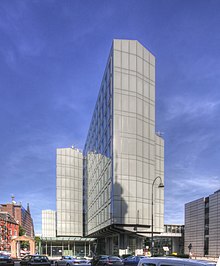
The WDR has the largest production capacities in Cologne . The different houses and systems of the transmitter are distributed in the city center in the Breite Straße (radio and television) and the district Bocklemünd in the Freimersdorfer Weg (television).
In addition, there are regional studios that produce and broadcast local programs for television and radio (local time from ...) .
- The WDR-Studio Düsseldorf is the most important regional studio of the WDR. It has been located in the government district of the state capital since December 1991 . The nationwide television program Westpol is produced there; the management of the regional programs department is also located there.
- Dortmund , the largest city in the Westphalian part of the country, is of certain importance as a location, since in addition to the regional broadcasts and the complete daily radio program of WDR 4, individual broadcasting lines for the television program, for the radio wave WDR 2 as well as the traffic news on radio are produced there . In addition, the Dortmund radio studio also serves as a replacement studio for the “Leitwelle” WDR 2. Studio Dortmund produces the nationwide television programs Planet Wissen , Planet Schule , Der schenkte Tag and Das Wort zum Sonntag . In addition, the 20-minute local television program “PunktDortmund” was produced in Dortmund, similar to the program “PunktKöln” in Cologne. However, both formats were discontinued at the end of 2006. In 2009, the Dortmund studio also produced the lunchtime program “Lokalzeit NRW”, which was also discontinued after six months.
Further regional studios are located in
- Aachen ( Aachen region ) ,
- Bielefeld ( East Westphalia-Lippe ) ,
- Bonn ( Rhine victory ) ,
- Duisburg ( Lower Rhine ) ,
- Essen ( Ruhr ) ,
- Münster ( Münsterland ) ,
- Siegen ( South Westphalia ) and
- Wuppertal ( Bergisches Land ) .
In addition to the studios, WDR has regional offices in Detmold , Kleve , Paderborn , Rheine and Arnsberg . Regional correspondents report from Ahaus , Krefeld , Minden , Monschau as well as the Hochsauerlandkreis and the Soest district (these belong to the WDR-Studio Siegen).
The national political reporting is carried out by the WDR radio studio in Berlin , a WDR television correspondent for the 3rd television program and by the television community editorial office of the ARD capital studio in Berlin .
WDR operates studios abroad in the following cities (partly in cooperation with NDR): Washington (USA), Brussels (Belgium), Paris (France), Moscow (Russia), New York (USA), Nairobi (Kenya), Warsaw ( Poland), Amman (Jordan).
Sound body
The WDR has five sound bodies of its own:
- WDR Symphony Orchestra Cologne ; the orchestra was founded in January 1946 as the successor to the former orchestra of the Reichsender Köln, founded in 1926, and had its first public performance on February 21, 1947 as the "Chamber Orchestra of the NWDR Cologne".
- WDR Funkhausorchester Cologne ; founded in 1947 as " Orchester Hermann Hagestedt " of the NWDR, has been supported by the WDR since 1956. The orchestra also appears together with the WDR Big Band Cologne as the “Big EntertainmentOrchestra”.
- WDR Radio Choir Cologne ; founded in 1947
- WDR Big Band Cologne ; founded in November 1947 as the "dance and entertainment orchestra Adalbert Luczkowski " of the NWDR, has been supported by the WDR since 1956. With the WDR Funkhausorchester Köln, the big band also appears as a “large entertainment orchestra”. Today they are considered one of the best big bands in the world, and in 2007 theyreceiveda Grammy Award for their CD Some Skunk Funk .
- WDR Children's Choir Dortmund ; Presented to the public for the first time on June 9, 2017, it is a cooperation between the WDR Rundfunkchor Köln and the Dortmund Chorakademie for children aged 9 to 13.
Holdings
Transmitters
The WDR operates several basic network broadcasters
- Transmitter for FM, DAB + and DVB-T2 on the Venusberg in Bonn
- Transmitter for FM, DAB + and DVB-T2 in Langenberg
- Transmitter for FM, DAB + and DVB-T2 on the Bielstein in the Teutoburg Forest
- Transmitter for FM, DAB + and DVB-T2 in Nottuln / Münster
- Transmitters for FM, DAB + and DVB-T2 on the Nordhelle
- Transmitter for FM, DAB + and DVB-T2 Stolberg -Donnerberg near Aachen
- Transmitter for FM, DAB + and DVB-T2 in Kleve
- Transmitter for FM and DAB + at Bärbelkreuz / Eifel
- Transmitter for FM and DAB + in Olsberg (transmitter Olsberg)
- Transmitter for FM and DAB + on the Oberste Henn (transmitter Ederkopf)
In addition, various filling transmitter locations are operated and transmission systems from Deutsche Funkturm GmbH are used.
Director of the WDR and its predecessor institutions
- 1926–1933: Ernst Hardt , director of WERAG
- 1933–1937: Heinrich Glasmeier , head of the "Reichssender Köln" established in 1934
- 1937–1941: Anton Winkelnkemper , director of the "Reichssender Köln"
- 1942–1945: The Reichsender Köln had ceased operations
- 1945–1947: Max Burghardt , director of the NWDR
- 1947–1961: Hanns Hartmann , director of the NWDR and from 1956 of the WDR
- 1961–1976: Klaus von Bismarck
- 1976–1985: Friedrich-Wilhelm von Sell
- 1985–1995: Friedrich Nowottny
- 1995–2007: Fritz Pleitgen
- 2007–2013: Monika Piel (ended her position early on April 30, 2013)
- since July 1, 2013: Tom Buhrow
TV directors from 1960
Only after the NWDR had been broken down into the NDR and the WDR in 1960 did the WDR set up its own television production. That is why the list of television directors does not begin until 1960. Initially, there were two television directors who called themselves "Fernsehdirektor I" (for the first) and "Fernsehdirektor III" (for the third program). Werner Höfer's long tenure began with the third program and ended with the first.
- 1960–1969: Hans Joachim Lange
- 1969–1971: Peter Scholl-Latour
- 1964–1977: Werner Höfer
- 1977–1985: Heinz Werner Hübner
- 1985–1992: Günter Struve
- 1992–2002: Jörn Klamroth
- 2002–2007: Ulrich Deppendorf
- 2007–2014: Verena Kulenkampff
- since May 1, 2014: Jörg Schönenborn
Radio directors from 1960
- 1960–1974: Fritz Brühl
- 1974–1993: Manfred Jenke
- 1994–1995: Fritz Pleitgen (later director)
- 1995–1998: Thomas Roth
- 1998–2007: Monika Piel (later director)
- 2007–2014: Wolfgang Schmitz
- since 2014: Valerie Weber
literature
- In tune with the times. 50 years of WDR . Cologne: Kiepenheuer & Witsch, 2006, ISBN 3-462-03582-7
- Gabriele Schulz, Stefanie Ernst, Olaf Zimmermann: The WDR as a cultural actor. Demand, expectation, reality . Berlin: German Cultural Council 2009, ISBN 978-3-934868-22-9
- Ulli Schauen: The WDR Jungle Book. Handbook for Free . Cologne: Verlag Ulli Schauen 2012, ISBN 978-3-00-037213-1
Web links
- Homepage
- The history of WDR in the ARD chronicle
- Law on "West German Broadcasting Cologne" (WDR Law)
Footnotes
- ↑ Law on the “West German Broadcasting in Cologne” (WDR law) , announcement of the new version of April 25, 1998 , accessed on the portalrecht.nrw.de on April 20, 2013
- ↑ ARD yearbook 2004/05, p. 61.
- ↑ except border areas, e.g. B. France, Belgium, GDR, Denmark, Switzerland, Austria
- ↑ [email protected]: www.radiojunkie.de - radio jingles and more ... Accessed June 16, 2017 .
- ↑ Kay Berkemeier: WDR print . November 28, 2015 ( wdr.de [accessed November 21, 2017]).
- ↑ Kay Berkemeier: WDR print . November 28, 2015 ( wdr.de [accessed November 21, 2017]).
- ↑ WDR Annual Report 2011 (PDF 5.89 MB) p. 77, on the WDR.de website, accessed on January 7, 2013
- ↑ WDR Annual Report 2011 (PDF 5.89 MB) p. 81, on the WDR.de website, accessed on January 7, 2013
- ↑ WDR Annual Report 2013 (PDF; 12.1 MB) p. 121 , accessed on July 22, 2019 .
- ↑ WDR Annual Report 2014 (PDF; 6.4 MB) p. 99 , accessed on July 22, 2019 .
- ↑ WDR Annual Report 2015 (PDF; 13.8 MB) p. 147 , accessed on July 22, 2019 .
- ↑ WDR Annual Report 2016 (PDF; 10.9 MB) p. 149 , accessed on July 22, 2019 .
- ↑ WDR Annual Report 2017 (PDF; 9.5 MB) p. 151 , accessed on July 22, 2019 .
- ↑ WDR Annual Report 2018 (PDF; 8.3 MB) p. 159 , accessed on December 28, 2019 .
- ↑ Josef Schmid: "Intendant Klaus von Bismarck and the campaign against the 'Rotfunk' WDR." In: Archives for Social History , Volume XXXXI / 2001. Summary
- ↑ a b Ann-Christin Sievers: At WDR it goes round - the strange story of a program complaint , Frankfurter Allgemeine Zeitung of May 21, 2010, features section p. 37.
- ↑ Press release of May 20, 2010 - WDR Broadcasting Council decides on program complaints against “cure undesirable” and “hard but fair”. WDR , May 20, 2010, archived from the original on May 21, 2010 ; Retrieved on May 21, 2010 : "The large majority of the committee came to the conclusion that the feature" Unwanted healing " violated the requirement of journalistic fairness (Section 5, Paragraph 4, Clause 3 of the WDR Law)."
- ↑ Councilor criticizes "high hurdles" for program complaints - WDR Broadcasting Council condemns the ointment broadcast. (No longer available online.) In: meedia.de. May 20, 2010, archived from the original on May 24, 2010 ; Retrieved May 23, 2010 . Info: The archive link was inserted automatically and has not yet been checked. Please check the original and archive link according to the instructions and then remove this notice.
- ↑ WDR Annual Report 2017 (PDF; 9.5 MB) p. 178 , accessed on July 22, 2019 .
- ^ Christiane Hoffmans: The silence of the WDR about its art collection. In: welt.de March 15, 2014, accessed on March 15, 2014.
- ↑ Six women raise allegations against WDR man Henke
- ^ Süddeutsche Zeitung: More than 1000 demonstrate in Cologne after the "Umweltsau" song. Retrieved January 8, 2020 .
- ↑ There are different assessments of the first sports report on German radio. On July 13, 1924, the Nordische Rundfunk AG (NORAG, forerunner of the NDR) broadcast a report about a rowing competition on the Hamburg Alster . The peculiarity of the broadcast from Münster a year later, also at a rowing competition, was probably that the microphone was carried outside the house and to the sporting event for the first time.
- ↑ Rundfunk Jahrbuch 1933, published by the working group of publishers of official radio magazines and the Reichs-Rundfunk-Gesellschaft , Verlag J. S. Preuss, Berlin 1932, p. 28f. The book is in the library of the Museum for Communication Frankfurt
- ↑ Peter Fuchs (Ed.): Chronicle of the History of the City of Cologne , Volume 2, 1991, p. 203
- ^ Werag - Official organ of the West German Broadcasting Corporation Cologne , Rufu-Verlag Cologne
- ^ About the yearbook of the West German Broadcasting Corporation 1929 , Rufu-Verlag Cologne
- ↑ quoted from Der Deutsche Sender , Edition 4, Volume 3, January 1932, p. 4
- ↑ Communications of the RRG of March 30, 1933, quoted from Ansgar Diller: Broadcasting policy in the Third Reich . In: Hans Bausch (Ed.): Rundfunk in Deutschland , Volume 2, p. 114, dtv 3184, Munich 1980, ISBN 3-423-03184-0 . It was only nine years later that Glasmeier fell out of favor with Goebbels because, as director of the Reichsrundfunk, he played too many symphonies instead of more entertaining music. See Goebbels Diaries 1941, p. 71.
- ↑ Ansgar Diller, Rundfunk bis 1945 , Volume 2, 1997, p. 126
- ↑ Communications from the Reichsrundfunkgesellschaft dated December 21, 1933, quoted from Diller, p. 171 f., As above
- ^ Konrad Dussel, Deutsche Rundfunkgeschichte , 2004, p. 98
- ↑ "Hör mit mir" magazine from February 1936
- ↑ Hans Jürgen Koch / Hermann Glaser, Ganz Ohr: A cultural history of radio in Germany , 2005, p. 141
- ↑ its functions were transferred to the "Reichssender Frankfurt"
- ^ Hotel Monopoly. Picture book Cologne, accessed on December 10, 2013 .
- ↑ Werner Strodthoff, Das Funkhaus am Wallrafplatz , in: Klaus Katz / Dietrich Leder / Ulrich Pätzold / Ulrike Ries-Augustin / Günther Schulz / Petra Schulz (editors and editors), In tune with the times. 50 years of WDR Kiepenheuer & Witsch , Cologne 2006, ISBN 3-462-03580-0 , pp. 288 and 291
- ↑ Markus Behmer / Bettina Hasselbring, Radiotage, Fernsehjahre: Studies on the history of radio after 1945 , 2006, p. 301
- ↑ Hans-Jürgen Koch / Hermann Glaser, Ganz Ohr: a cultural history of radio in Germany , 2005, p. 230
- ↑ [1] , [2] , [3] ARD-Chronik des Deutschen Rundfunkarchivs, accessed on December 2, 2013.
- ↑ Press release Pleitgen: Internet will in future be the third pillar of the program ( Memento from June 29, 2008 in the Internet Archive )
- ↑ Telepolis: "Nobody likes us"
- ↑ 10 years of WDR online ( Memento from September 30, 2007 in the Internet Archive )
- ↑ Domain gone? So what? intern.de, November 11, 2002, accessed October 11, 2012 .
- ↑ DWDL.de: New logo: The WDR abolishes its angle
- ↑ Funkhaus am Wallrafplatz. "The Funkhaus am Wallrafplatz - The first address for communication in Cologne" WDR Cologne, July 2001, accessed on December 9, 2013 .
- ↑ Katrin Vernau confirmed by a large majority as WDR administrative director. In: wdr.de. WDR, May 2, 2019, accessed on August 6, 2020 .
- ↑ http://www1.wdr.de/unternehmen/der-wdr/standorte/studios/index.html
- ↑ WDR and Chorakademie Dortmund present the WDR Children's Choir Dortmund to the public. Retrieved December 28, 2019 .
- ^ WDR Children's Choir Dortmund. Retrieved December 28, 2019 .
- ↑ wdr.de - locations of the broadcasting systems of the WDR ( Memento from January 3, 2006 in the Internet Archive )
- ↑ Press release of the WDR Broadcasting Council from April 19, 2013: Farewell Director Monika Piel , accessed on August 6, 2020
- ↑ DWDL.de from June 16, 2013: Tom Buhrow will take over as WDR director on July 1, accessed by Thomas Lückerath on June 18, 2013
Coordinates: 50 ° 56 '25.4 " N , 6 ° 57' 4.3" E


